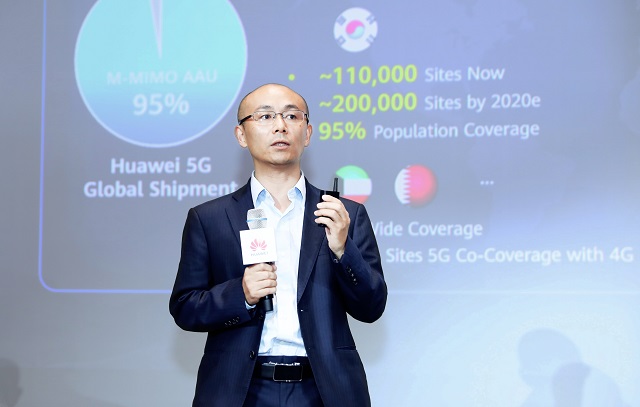Huawei Wireless Product Line Vice President Gan Bin has revealed three 5G trends at the Huawei Global Analyst Summit 2020.

Trend 1
Massive MIMO predominantly using TDD spectrum has become a standard practice during the first phase of 5G rollout.
Telecom operators in China have constructed 200,000 such sites and the number is expected to hit 800,000 by the end of 2020 in more than 340 cities.
Speedtest has reported a ten-fold data rate improvement on 5G networks over 4G networks. Additionally, Massive MIMO using TDD 3.5 GHz are co-sited with legacy 4G networks to ensure satisfactory coverage both outdoors and in easy-to-cover indoor areas.
While TDD is limited in uplink coverage and experience, FDD ensures balanced transmission in the uplink and downlink. FDD provides better in-depth coverage indoors, and enables operators to quickly roll out 5G using existing resources.
TDD and FDD convergence can deliver a better experience and coverage, particularly in the uplink, in some European countries where 5G is made compulsory. This convergence will further meet high uplink bandwidth requirements of B2B applications.
Trend 2
Current 5G commercial networks are mainly designed around B2C and B2H services, which is far from enough to fulfill the goal of B2B applications that call for industry-wide digitalization. 5G networks are enough to accommodate high-speed enhanced Mobile Broadband (eMBB) applications in industries.
China-Japan Friendship Hospital provides 5G HD video-based teleconsultation, West China Second University Hospital has implemented 5G-based ICU visits and mobile ward rounds, and 5G network coverage has been provided in over 300 hospitals in China.
Industrial applications that require low latency and high reliability based on ultra-reliable low-latency communication (URLLC), such as port, manufacturing, vehicle-to-everything (V2X), and power grid, are also being explored. Such applications will sure see commercial adoption as 5G network capabilities further support URLLC.
Trend 3
In the 5G era, operating expenses must be reduced, since the co-existence of multiple RATs and frequency bands is inevitable. 2G and 3G phase-out (17 networks already abandoned globally and 12 to be phased out) will help operators cut Opex. Simplified deployment saves site deployment costs for operators. Multi-RAT and multi-band coordination improves network O&M and energy efficiency.
5G network construction must take both capacity and coverage into consideration from the beginning to ensure consistent user experience. Macro base stations are the core of 5G network experience and coverage. Pole sites fill coverage holes in areas where site deployment is difficult. Indoor micro base stations provide optimal experience for users in high-value areas.
The growing number of access technologies, bands, and modules is placing global operators under challenges to obtain enough space for antenna installation. For macro sites, Huawei’s Blade AAU enables a high level of integration between TDD Massive MIMO AAU and FDD passive antennas in one box. This allows for simplified TDD+FDD deployment by utilizing the existing poles, helping shortens the deployment time by 85 percent.
For pole sites, Huawei said it TDD+FDD converged Easy Macro 3.0 and Book RRU 3.0 enable one-time deployment to fill up both 4G and 5G coverage holes, while also allowing FDD bands to provide TDD anchoring in NSA architecture. This facilitates smooth evolution to 5G on FDD bands through software upgrade.
In terms of indoor micro base stations, Huawei LampSite supports TDD+FDD convergence, enabling operators to significantly improve 4G and 5G user experience in high-value indoor areas with one-time network deployment.
In addition to mainstream TDD bands, sub-3 GHz FDD bands allow 5G networks to quickly achieve coverage in some countries. Deploying 5G on new FDD spectrum offers an effective approach to greatly improve spectral efficiency and user experience.
For 5G networks on FDD spectrum, dynamic spectrum sharing (DSS) enables millisecond-level dynamic allocation of spectrum resources between LTE and 5G services, which is conductive to maximizing spectral efficiency.
Super Uplink enables FDD uplink spectra to supplement TDD bands. This enables TDD and FDD spectrum coordination, improving uplink capability and reducing transmission latency. Also, uplink-only deployment can be implemented to further improve uplink performance.
In commercial networks, with TDD supplemented with FDD uplink spectra, Super Uplink allows for a maximum of uplink experience improvement by four times. The Super Uplink industry chain is increasingly mature from chips, modules, to terminals, accelerating E2E network maturity.





